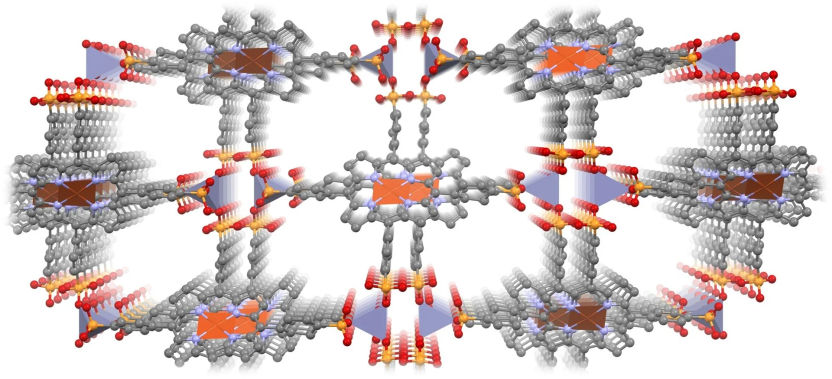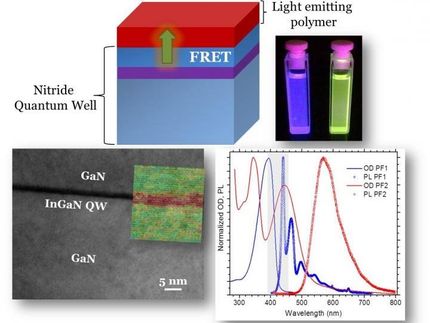New Material for Energy Storage and Optoelectronic applications
“GTUB3” is the first microporous, metal-organic solid that is both conductive and photoluminescent
Researchers at TU Berlin have developed a new material from the class of microporous, metal-organic framework (MOF) compounds. On the one hand, such compounds can store small molecules and gases such as hydrogen, CO2 or even toxins. On the other hand, the large surface area resulting from the high volume of pores means they are also suitable as a material for electrodes such as in supercapacitors, which can be charged much faster than conventional batteries. The problem to date is that the majority of MOFs are very poor conductors of electricity. The new material created by the researchers, called GTUB3, is both a good conductor as well as chemically and thermally extremely stable. What makes it unique is that it is also photoluminescent, meaning that it glows when irradiated with light. As a result, it could also be used in optoelectronic applications and solar cells.

The 3D structure of the new GTUB3 material with pores
© Gündoğ Yücesan
Metal-organic frameworks, or MOFs, are considered one of the most exciting classes of materials in modern chemistry. They consist of metal atoms directly bonded to organic molecules. “In the past, we only valued such crystal structures for their aesthetic beauty. Some of them actually call to mind Moroccan tiles,” explains Dr. Gündoğ Yücesan from Faculty III - Process Sciences at TU Berlin. “What makes them interesting today are the many cavities that make microporous MOFs ideal storage media as well as their large surfaces, which facilitate reactions.”
Modular construction
Above all, new compounds in this substance class can be developed in a highly systematic way due to the modular structure of their molecules. Inorganic building units - or IBUs - are connected to each other via long-chain organic struts - in other words linkers. This enables large-scale elementary structures to be formed, which are then repeated either in layers or stacked as building blocks to form crystals.
Heat-resistant and chemically stable
While there are already more than 100,000 MOFs, there has been little development as yet in some areas of this research field. “Especially regarding microporous MOFs containing phosphorus, of which there are less than 50 so far,” says Yücesan. “They piqued our interest because the first known phosphorous MOFs turned out to be thermally and chemically very stable.” Ideal properties for electrode materials that have to be able to withstand long periods in electrolytes or even acids, including when it gets hot during reactions.
Conductive in all three spatial directions
The main problem is that MOFs are generally insulators - a poor basic property for electrodes through which charge carriers are required to flow. In response, in 2020 Yücesan and his team designed two microporous phosphorous MOFs with higher conductivity, “TUB75” and “TUB40” (named after TU Berlin), working in collaboration with other universities and research institutes. The creation of GTUB3 provided a chance to honor the contribution of Gebze Technical University in Turkey. In addition to phosphonic acid, the new compound contains the metals copper and zinc as well as porphyrin, which consists of four carbon rings. All these starting materials are cheap, available in large quantities and non-toxic to humans and the environment. Unlike its two predecessors, the semiconductor GTUB3 is equally conductive in all three spatial directions and temperature-resistant up to 400 degrees Celsius.
Use in supercapacitors for cars, buses and trains
Gündoğ Yücesan sees great potential for GTUB3 in the improvement of supercapacitors, such as those used for short-term electricity storage in the recovery of braking energy in buses and trains as well as in some cars. These supercapacitors are electrochemical energy storage devices with very high power density that can be charged many times faster than conventional batteries. However, they store far less energy than batteries of the same mass. New electrode materials - such as GTUB3 - are intended to reduce this gap. “The new compound is also suitable for the thin-film processes often used in industry for application on substrates,” explains Yücesan.
Interesting properties for LEDs and solar cells
As a kind of added bonus, GTUB3 is also photoluminescent, meaning it emits light when irradiated. This is essential for the functioning of both light-emitting diodes (LEDs) and solar cells. This range of properties makes the new material an ideal starting point for the development of a whole family of phosphorus-based MOFs, Yücesan is pleased to say. “Phosphonic acid also has a large number of binding possibilities to metals, which gives us plenty of scope in our development work.” TU Berlin has already applied for a patent for GTUB3, the nucleus of this family.





























































